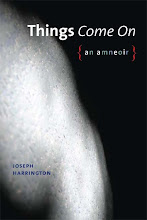Finally got and read O Bon, by Brandon Shimoda (Litmus 2011) - the poems have a
combination of delicacy and creepiness that's hard to get over. I wish I
could write poems that used syntactic disjunction and reversals to such
precise effect/affect. I'm also very interested
in the relation of narrative to lyric here - just enough of the former to
generate the latter. It kind of reminds me of the m.o. of Susan Howe or
Cecil Giscombe in that it's clear that the poems are "based in" or
incited by research, but there's not too much of
the actual research in the poems. They are more like an emotional or
psychic distillate of the events. Which is why they have such force. You can get all of the narrative or sources that you need (or want -- or not) in the 5-page afterword.
The book is really an elegy for the poet's grandfather, a Japanese immigrant photographer, born in Hiroshima, interned during WWII. Japanese ritual and mythology provide much of the imagery and feeling-tone of the book -- for instance, the Corpse Eater, a former priest doomed to cannibalize the deceased (in Japan, this is folklore; in early modern Europe, it was real life). Shimoda is well aware of the Freudian link between cannibalism (symbolic) and melancholia: ". . . I have found myself, repeatedly and throughout O Bon, feasting off of what is resurrected, eating my grandfather's corpse, turning it over in my mouth, as the rest of my body burns out of the sound" (89). Like Genet in Funeral Rites, Shimoda in O Bon accepts, embraces, and explores the implications.
Now, in keeping with my practice of randomly selecting excerpts from books I am describing . . . from "In the Middle of Migration":
we find ourselves
turning --
recalcitrant in the ancient domain
masks simultaneously black
we know not
the sensible thing
sugar mammal, slit throat
thethered to the thickest spar
between home and adopted home
makes no difference in times like these
without bothering to unfold the map
or take it from its sleeve
climb the rungs of bone and limb
to pierce what version of skin or sky
the solvent leaks
(35)
I will admit to deliberately choosing left-justified lines for this passage -- which in fact characterize few of the poems -- in order to conform to the almighty Google formatting. But as the multiple spaces between stanzas suggest, these poems are composed of words and the spaces between the words. You should look at the book to get a sense of what Shimoda does with the space of the page. I can't replicate the indentations that "set off" this stanza (in more ways than one): "a visage / nettling the slack / foundation -- may I beg shelter for the night / misshapen where / shall I alight / the valley hymns in the crust" (23).
Want more? See Jerome Rothenberg's blog, where same can be found. Shimoda is interested in contemporary Japanese poetry (vide the poet's ANCIENTS project), from which he has undoubtedly drawn formal inspiration.
"You only give me your funny papers"
-
The man in his 60s had been talking to people at the United gate; he was
clearly a man who liked to converse. We sat next to each other in row 28. A
v...
3 days ago










